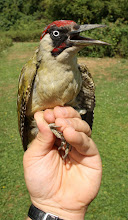Oh, no I didn't ...
But which is it?
I'm in Gloucester now until the end of the year. Depending on the weather at my Dad's house, I might get some ringing in - there are 4 Blackbirds hanging around daily on the patio, each with a ring on (more than likely mine) as well as Dunnocks, Coal Tits and plenty of Blue Tits (no change there then!). Having done all the ringing I am going to do this year in Bedfordshire, it's time to do a final check on totals.
The final count for Priory Country Park this year was 986 handlings. The weather (mainly) and other commitments meant I didn't make a final attempt to catch the extra 14 birds I would need to make it 1000 for the year. Having caught over 1400 last year, I'm not so fussed.
As you may have read previously, my totals at Sandy Smith Nature Reserve (SSNR) have been subject to much fretting over whether I would make 1000 or not. Last year, I reached 999 handlings. One more hour (or less) of effort in 2011 and I wouldn't have been thinking twice about my totals for this year, but as somebody pointed out I had failed (in jest, of course), I had to make sure of 1000 this year.
In my last post, I wasn't sure if I would make it. Decent catch totals in November and early December were making the target achievable, but totals suddenly dropped off after the cold snap melted and the rains returned. The luck that brought a foreign control Blackcap one weekend and a foreign control Siskin the next (with 70+ other birds), deserted me.
Heavy rain and strong winds stopped ringing activities on at least one day each weekend. So on Friday 21st, with a forecast of heavy rain for the weekend and parents demanding my return to Gloucester ASAP, I decided to take the day off work and set my nets. Come what may, at the end of the day, the likelihood was that if I hadn't reached 1000 handlings, that would be it. Being 25 birds short, I figured that it was possible (30 was the total on the previous weekend).
Liz, the Greensand Trust ranger for the site made an unexpected visit and gave me some encouragement!
Above: Shortly afterward Liz's visit (I say shortly but in ringing terms, 2 hours + is a long time if you're not catching many birds) I caught this Great Spotted Woodpecker. Handling no. 1000 in 2012 for SSNR.
I made it! Now for some well earned rest (and the inevitable cold that comes when you stop). Merry Christmas to you all. I hope you have a good New Year.


